Introduction
The statistics show that, in winter, the percentage of vehicle breakdowns caused by battery problems increases by 20% and 30%. Having the best car batteries with reliable performance for cold weather becomes crucial for car owners. Cold weather can bring challenges for your vehicle’s batteries, whether you’re starting your car on a frosty morning, using your RV for a winter adventure, or powering your solar storage system during a chilly night. Reliable batteries help you to not be stranded without power.
With so many batteries available for the vehicle, most people may be confused. In this guide, we will cover the types of batteries available, the criteria that make a battery suitable for cold weather and the best choices for different applications in this guide.
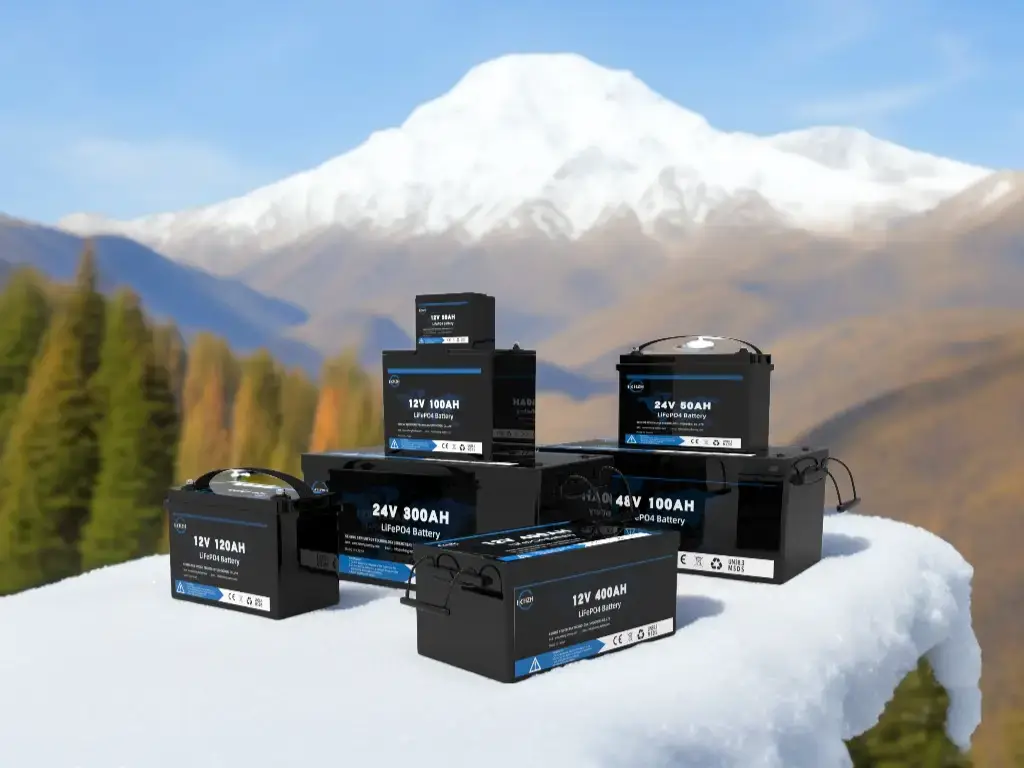
Types of Batteries Suitable for Cold Weather
In cold conditions, lead-acid, AGM, and lithium-ion batteries are the three main battery types that stand out.
Lead-Acid Batteries
Lead-acid batteries are a common choice for many uses in cold weather. People use them in car batteries, RVs for deep-cycle batteries, and for solar panels. They are easy to find and not too expensive. That’s why many people often choose them.
However, lead-acid batteries have some issues in colder temperatures. They can get rapid power loss and potential water loss and might even freeze. This will be exacerbated in warm areas before the cold season begins. Also, they need regular care. This includes cleaning off rust and checking the liquid inside. Doing this maintenance can be difficult in cold conditions.
AGM Batteries
With the introduction of Absorbent Glass Mat (AGM) batteries, lead acid batteries got a big upgrade. AGM batteries have a special design. They put absorbent glass mats between the lead plates. This design helps them work better in cold weather and reduces their environmental impact. It also protects them against shaking. Besides, AGM technology stops loss of water and other liquid, which is a big problem in cold places. AGM batteries keep more of their power and can release power better in the cold compared to traditional lead-acid batteries. Still, they don’t perform as well as LiFePO4 batteries.
Lithium-Ion Batteries
Lithium-ion batteries, particularly lithium iron phosphate (LiFePO4) batteries, offering unmatched power, have emerged as a superior alternative to lead-acid batteries for a wide range of vehicles in cold weather. Relaed Post: LiFePO4 Battery Temperature Range: Balancing Performance and Durability
LiFePO4 batteries offer several advantages, including:
| Excellent cold weather performance | LiFePO4 batteries offer superior performance of discharge and capacity retention even in the sub-zero temperatures, which makes them the best choice for cold extreme conditions. |
| Longer lifespan | LiFePO4 batteries can last up to 10 times longer than lead-acid batteries, providing a better long-term investment. |
| Lightweight and compact | Lithium-ion batteries are usually lighter and smaller in size which makes them easier to install and carry compared to lead-acid batteries. |
| Low maintenance needs | LiFePO4 batteries are maintenance-free, eliminating the need for regular fluid checks and corrosion cleaning. |
| Fast charging | Lithium-ion batteries can charge much faster than lead-acid batteries, reducing downtime, providing enough power and ensuring that your equipment is always ready to go. |

Factors to Consider When Choosing a Cold Weather Battery
Cold temperatures can have a significant impact on battery performance, affecting factors such as capacity, discharge rate, and overall lifespan. To ensure that your battery can withstand the challenges of cold weather and provide reliable power when you need it most, it’s essential to consider the following factors when choosing a cold weather battery:
Cold Cranking Amps (CCA)
CCA is a kind of a battery’s ability to start an engine to in frigid temperatures. In cold weather, engine oil becomes thicker, resulting in sluggish engine cranking due to the increased difficulty for the engine to turn over. A battery that is rated higher for CCA will provide the amount of power needed to start the engine in the mentioned circumstances. For example, a battery with a CCA rating of 800 can deliver 800 amps for 30 seconds at -18°C (0°F) before the voltage drops below 7.2 volts. When selecting a battery for cold temperatures, opt for a CCA rating that is at least 20 % higher than the specifications of your vehicle.
Reserve Capacity (RC)
Reserve Capacity refers to the amount of time a battery can maintain a consistent voltage level under a specified load before it is fully discharged. When it is cold, the battery’s capacity is reduced and it may have to work harder to keep the electrical components like the heating system and the lights powered.A battery with a higher RC can provide a steady power supply for a longer period, ensuring that your vehicle or equipment can operate reliably in cold conditions. When selecting a battery for cold weather, choose the one with the highest RC to make up for the power-increasing demands.
Depth of Discharge (DoD)
DoD refers to the percentage of a battery’s capacity that has been discharged. Deep-cycle batteries like those found in RVs and solar power systems can usually tolerate DoDs of 50%-80% before the battery is damaged. However, in cold weather, it’s essential to limit the DoD to prevent freezing and extend the battery’s lifespan. Try to maintain DoD of 50% or less in cold weather situations, and recharge the battery after use.
Self-Discharge Rate
All batteries experience some level of self-discharge, which is the gradual loss of charge over time when the battery is not in use. In cold weather, lead acid battery self-discharge rate can increase by up to 60% while lithium-ion batteries self-discharge rate is only around 3-5% per month. A higher self-discharge rate means that you’ll need to recharge your battery more frequently, even when it’s not in use. In order to reduce the self-discharge in cold weather, opt for a battery that has a low self-discharge, like the lithium-ion battery.
Maintenance Requirements
Traditional lead-acid batteries require regular maintenance, such as checking fluid levels and cleaning corrosion. The main problem to overcome in the winter is the keeping the outside facilities in order. To avoid these issues, consider low-maintenance or maintenance-free batteries, such as AGM or lithium-ion batteries. These battery types are like sealed containers and they do not need for fluid checks or corrosion cleaning and consequently they become more reliable and convenient in use during extremely cold weather.
Other considerations include vibration resistance for rough terrains and deep discharge cycles for applications like solar storage or electric vehicles. All these factors are the ones that exert the greatest impact in the functioning and lifespan of your battery in low temperatures.
Best Lithium-Ion Batteries for Cold Weather
According to our careful research, lithium batteries are rewriting the power storage rules with their better performance, durability and efficiency than lead-acid and AGM batteries. While the initial investment may be higher, the benefits of lithium-ion technology in the long run make it a smart and cost-effective choice.
Lithium-ion batteries with inherent heating systems are the informed decision for those who need reliable and high performance batteries to power the devices in cold weather conditions. The integrated heating mechanism, controlled by an advanced technology – Battery Management System (BMS), maintains optimal battery temperature by connecting to a heating plate. Thanks to this novel design, the battery will be able to maintain consistent performance in the extreme weather conditions.
Lithium-ion batteries with heating capabilities provide uninterrupted, consistent power in cold climates, high altitudes, and remote highland regions, offering a viable alternative to traditional batteries. Being the top brand of cold-weather batteries, Keheng has a variety of state-of-the-art lithium-ion batteries that are customized to your particular requirements.
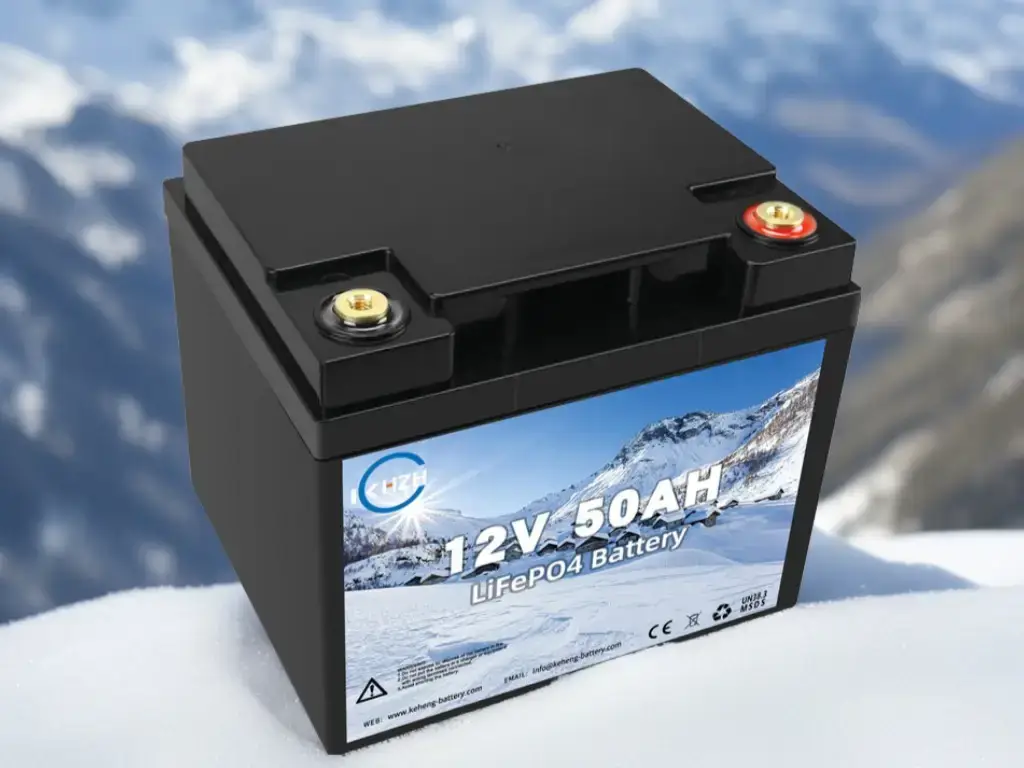
Smart 12V 50AH LiFePO4 Heated Battery
The Smart 12V 50AH LiFePO4 Heated Battery is a versatile choice for a wide range of cold weather applications, including RVs, boats, hot rods, solar power systems, and off-grid cabins. With a 50Ah capacity and a robust 1000A CCA rating, this battery provides reliable starting power and deep cycling capabilities, even in temperatures as low as -30°C (-22°F). This battery can be used as a drop-in replacement for traditional lead-acid batteries, with a similar form factor and terminal configuration. It’s perfect for those who need a compact, lightweight, and maintenance-free battery that can handle the rigors of cold weather.
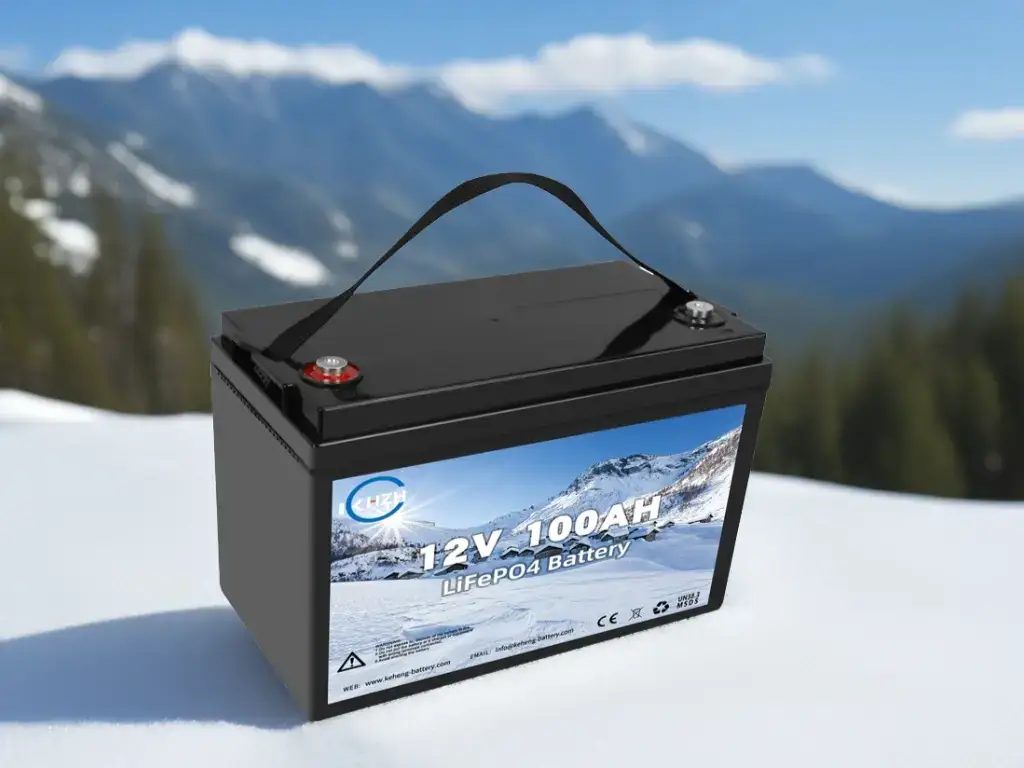
Heated 12v 100ah Lifepo4 Battery
For those who need a bit more power and runtime, the Heated 12v 100ah Lifepo4 Battery is an excellent choice. This battery boasts a generous 100Ah capacity, making it perfect for larger solar power systems, electric vehicles, and backup power applications in cold climates. With a charging rate of 0.5C, this battery is designed for efficient charging, allowing it to reach a significant level of its capacity within two hours, minimizing downtime. The Heated 12v 100ah Lifepo4 Battery is designed for parallel connection, allowing you to scale up your power system as needed. Its vibration-resistant design and IP67 waterproof rating make it suitable for use in harsh winter environments, such as construction sites or remote locations.
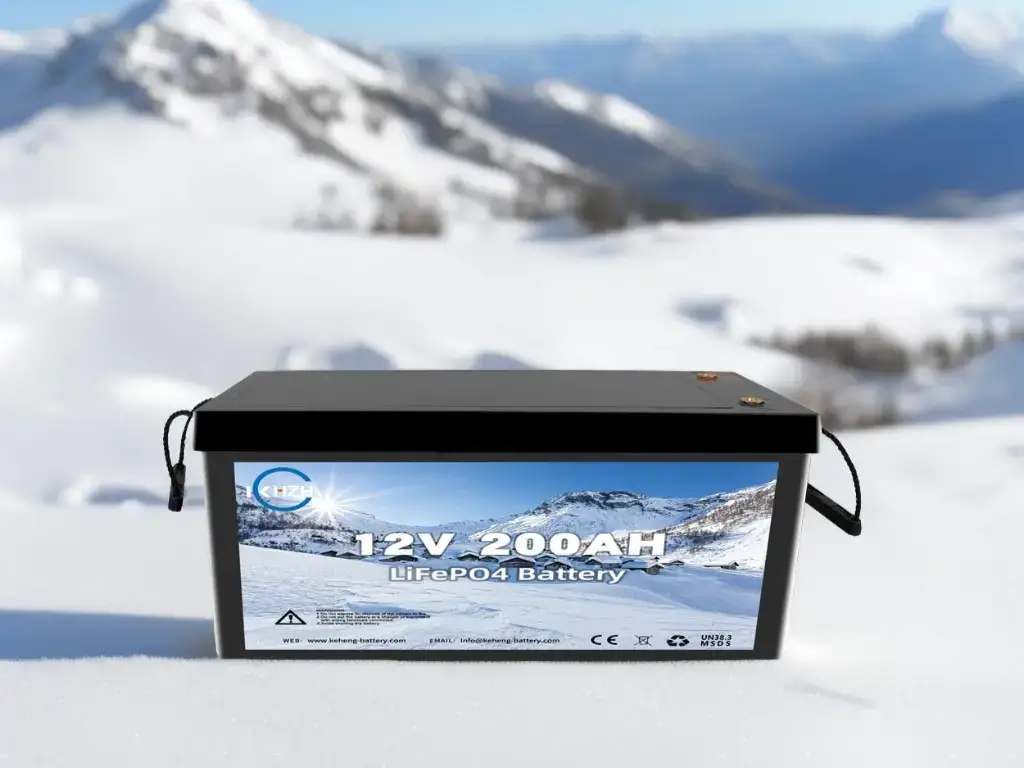
12V 200ah LiFePO4 Battery With Low Temperature
This battery is the one that will satisfy your and your tools’ demanding power requirements even in the most demanding situations. This battery has an amazing 200Ah capacity which makes it number one choice for heavy-duty applications such as large scale solar energy storage, commercial vehicles, and industrial equipment in extremely cold conditions. Presenting the cycle life of over 2000 cycles at 100% discharge depth and a lifespan of about a decade, this battery provides tremendous value for people who need a power source with high capacity and very long life in the most formidable climates. Its flexibility is one of its main advantages: it can be used in a series or parallel configuration, which will create 24V, 36V or 48V systems. Therefore, it is a good choice for many different kinds of applications.
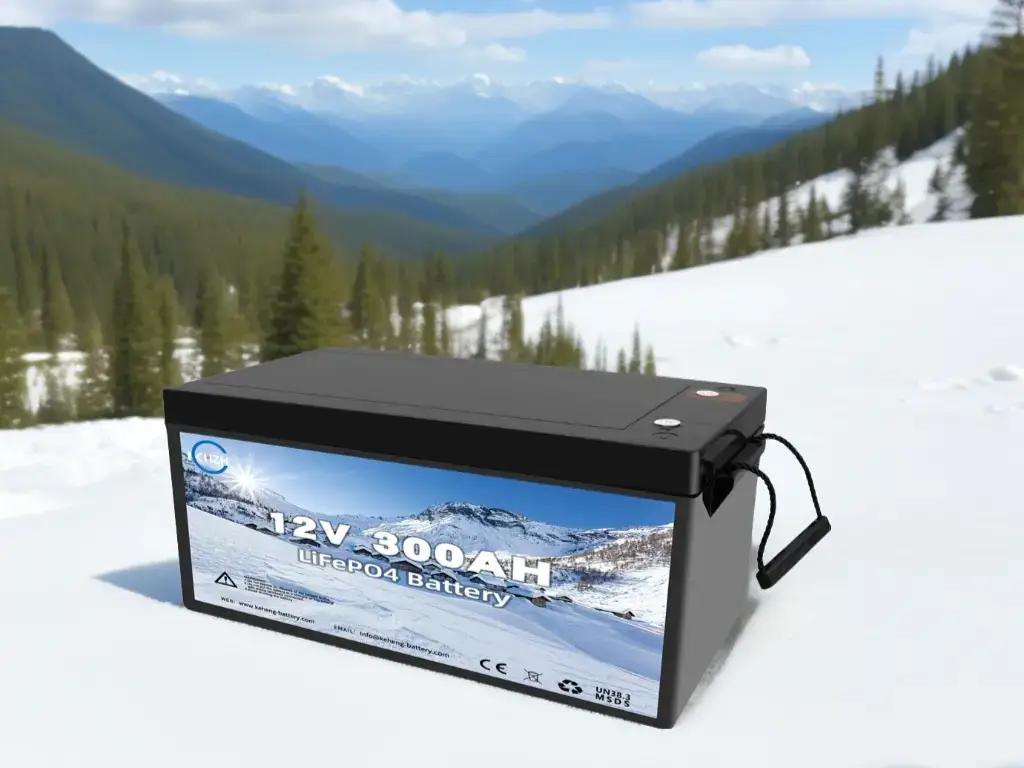
Heating Series 12V 300AH LiFePO4 Battery
The Heating Series 12V 300AH LiFePO4 Battery is one of the top choices for unmatched performance in cold temperatures and high-end power needs. The power station with an exceptional 300Ah capacity has proven its worth in the fields of heavy-duty energy storage, industrial equipment, and commercial vehicles in the most extreme winter conditions. This battery offers an impressive lifespan of 10 years and over 7000 cycles, providing reliable power and peace of mind for years to come. It is the ultimate choice for those who demand nothing less than the ultimate cold weather power solution.
Maintenance Tips For Battery in Cold Weather
Taking care of your battery during cold weather is a must. It contributes to the fact that the battery life is extended and works properly.
- Always ensure your battery is fully charged. The battery that has been fully charged is much less susceptible to freezing than the one that is empty.
- You need to do the voltage check with a battery tester regularly. As a result, the battery will not fail unexpectedly. In cold areas, a 12-volt battery should be kept charged at 12.6 volts or above for the best operation.
- Consider buying a smart battery maintainer. This charger adjusts the charging rate according to the temperature. It prevents the battery from overcharging in the cold.
- Covering your battery with a high quality battery blanket or using a portable heater is also a good idea to consider. This ensures that the battery is warm and protects it from extreme cold.
- Clean the battery terminals often. This prevents rusting and will keep the battery working in a good condition.
- If you’re not using your battery in the winter, like in RVs or boats, keep it in the place where the temperature can be controlled. It can therefore reduce the extent to which the battery’s power is affected by the cold weather and its longevity.
Conclusion
Picking the right battery for cold weather is decisive. This will give you a trustworthy power source with outstanding power. It will work well even under the harshest conditions. One must pay attention to the choice of the lithium battery with heated and high CCA (Cold Cranking Amps) ratings for cold climates. These characteristics make the battery to be able to start in cold weather. In addition, the battery should have sufficient capacity to support your activities. Moreover, you must not forget about preventive maintenance. Proper maintenance is of great significance, which is essential for achieving the best performance and increasing the life of your battery in cold weather conditions.
Keheng: We are Your Recommended Supplier for Lithium-Ion Batteries
Keheng is a front-line lithium-ion batteries producer. They have a wide selection of superior batteries for different uses and occasions. Of their range, the LiFePO4 battery is unique in that it is the most effective in cold temperatures. This way, it is both a perfect option for the individual users and businesses. You are opting for a Keheng lithium-ion battery, provided by a known brand, that will offer you trustworthy and efficient performance for cold-weather usage. If you are in search of the most suitable battery for your purpose, please visit Keheng’s website and evaluate it against its choices for cold weather.
Frequently Asked Questions (FAQs)
What is the best battery type for cold weather?Lithium-ion batteries, particularly LiFePO4 batteries, are the best choice for cold weather due to their excellent low-temperature performance, long lifespan, and low maintenance requirements.
Can I use regular batteries in cold weather?While regular batteries can be used in cold weather, they are more susceptible to freezing and capacity loss compared to lithium-ion batteries. If using regula batteries, be sure to keep it well-maintained and insulated.
Can I use a lithium-ion battery in extremely cold temperatures?Yes, lithium-ion batteries, especially LiFePO4 batteries, are designed to perform well in extremely cold temperatures. Some even feature built-in heating systems for optimal performance in sub-zero conditions.
What should I do if my battery dies in cold weather?If your battery dies in cold weather, attempt to jump-start it using jumper cables and another vehicle’s battery. If jump-starting fails, replace the battery with a new one designed for cold weather performance.
How often should I charge my battery in cold weather?In cold weather, it’s essential to keep your battery charged as much as possible. If your vehicle or equipment is not in use, charge the battery every 30-45 days to maintain its charge and prevent sulfation or over-discharge.
Can I store my battery outside in cold weather?It’s not recommended to store your battery outside in cold weather, as exposure to extreme temperatures can cause damage and shorten its lifespan. Instead, store your battery in a cool, dry place, such as a garage or shed.
How can I tell if my battery is damaged due to cold weather?Signs of cold weather damage to your battery include reduced capacity, slow charging, difficulty starting engines or powering equipment, and visible damage such as cracks or leaks. If you suspect your battery is damaged, have it tested by a professional or replace it with a new one designed for cold weather use.




1 thought on “Discover the Best Batteries for Cold Weather: An In-Depth Analysis”
Hiya very nice web site!! Guy .. Excellent .. Amazing .. I’ll bookmark your website and take the feeds additionally…I am happy to search out so many useful information right here within the put up, we need work out extra strategies in this regard, thanks for sharing. . . . . .